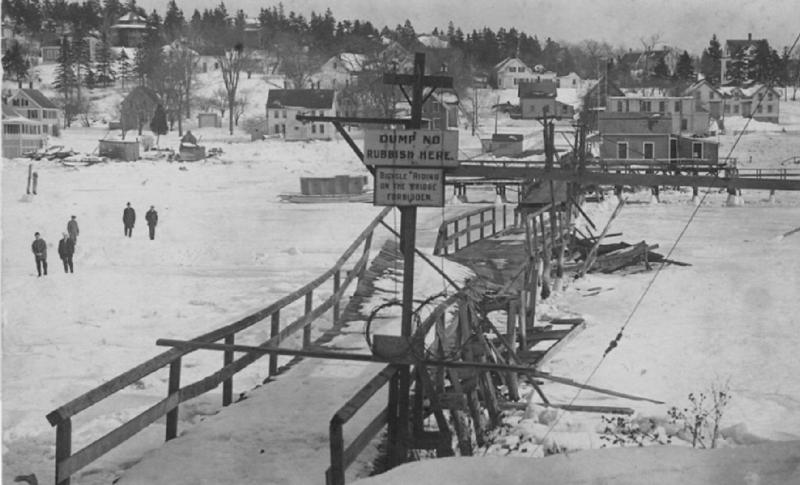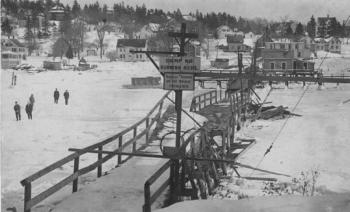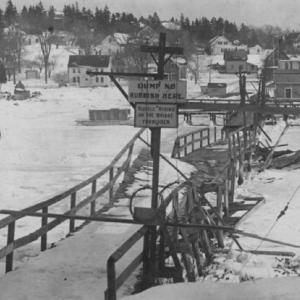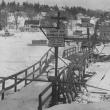The Footbridge, Part II
Cut Off
Remember we're still before the age of the widespread use of motorized land transport. Cut off by the footbridge from waterborne access were a number of businesses at the head of the harbor. The old grain mill, then run by Harold W. Bishop, was the largest of them, with constant schooner deliveries of flour, grain, kerosene, brick, hay, fertilizer, pipe, cement, and other products. Later a small tanker carrying heating oil came in. Lumber arrived for the Boyd business, on the site of Grover's. There was also Mosher's cooperage and a couple of boatshops, as well as ferry man Taggart's grocery store. The answer was a swing section of the bridge that was man-powered. A bridgetender inserted a long bar into a cogged mechanism to crank the bridge open as he walked around in a circle pushing the bar. The Southport bridge was formerly operated thus, as is the Barters Island bridge.
Bridgetenders
1903 saw the first town appropriation for a bridgetender—$50 at first. By 1905 Henry Pinkham was getting $75, the next year William Foster got $100. Sumner Pierce became tender in 1908, and Harold Bishop in 1911. They all lived or worked near the footbridge. Pierce had a stonecutting operation for a few years at the west end of the footbridge; Bishop, and later Hume, and then Marson Brothers, ran the grain mill bulk supply business nearby; they were paid to tend it for decades. That tells me that over the decades it was the most active business north of the footbridge, needing the swing section most.
In 1950 the current business at the old mill, Anderson & Gaw, was paid for tending the draw. Red Giles, who drove an oil truck for them in the mid-1900s, told me that the bar to crank the swing section stood in a corner of the business, dusty and idle in his day. Though 50 years rolled by, the payment of $75 a year never increased—I presume the workload decreased significantly. In 1955, Farnham & Brewer, boatbuilders at the head of the harbor, popped up as tenders, then no mention was ever made again of tending the draw. David Tibbetts told me that his father Leon had a spot he liked at the head of the harbor where he'd ground his boat out when it needed upkeep. In the 1980s, Leon used a key to unlock the padlock on the swing section, and he'd open it for his own use by pulling the swing section around with his boat.
Lack of mention of a tender does not necessarily mean there was none paid by the town. One of my great regrets of the modern era is the generalization of town reports. Huge categories smother the reality of the monetary life of the town. Formerly every payment was listed, by name or reason or both—every pauper payment, every man who worked on the roads, including the cost and supplier of every bottle of mucilage used in the office. The 1942 report was a big step into the big word world. The mid-1950s saw another round of increasing summarization. Financial reports in town reports are now famously obtuse and baffling./
Repairs and Rebuilding
By 1909 the town made regular outlays of $100 or $200 for routine repairs to the footbridge, while by 1911, $300 went to a new draw built by William Brown. A town landing was moved to the footbridge in the 1910s, a fitting spot easily accessible from both sides. A major expenditure came in 1918, a couple of years after the bond issue was paid off. I've detailed the Freeze of 1918 that, among other things, wrecked the footbridge in the book, Sketches II. The town paid Elbridge Giles $550 to rebuild it. He must have built a sturdy structure since well-known machinist Hite Thurston crossed the footbridge in his car in 1921, the first to do so.
Then in 1927, nine years after the Freeze repairs, the town borrowed $5,500 from Peleg Patten of McFarlands Point to rebuild again with Elbridge on the job again. Just two years later another $800 went for a new draw. In 1930 the Register ran a story that a fellow bet he could cross the bridge in his car. He succeeded, but was met by Officer Sherb Hodgdon on the other side who slapped a big fine on him and took his license. By 1930 the separate footbridge repair and tending articles were moved into the general category of Roads and Bridges and are lost, though tending was broken out every once in a while.

























